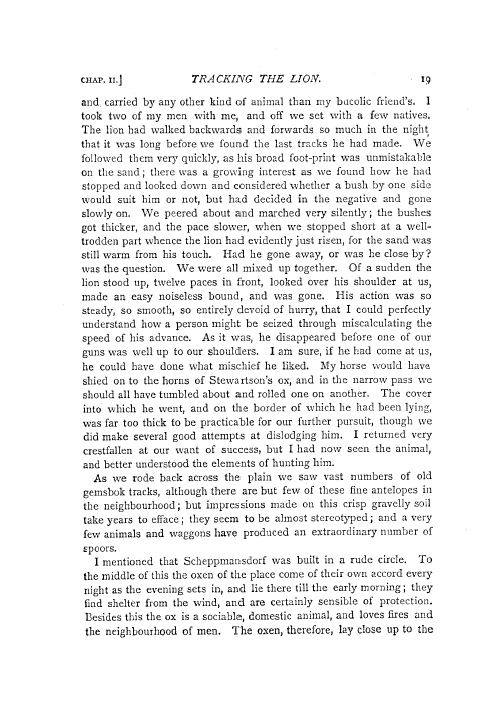CHAP. II] TRACKING TIIE LION. 9
and, carried by any other kind of animal than my bacolic friend's, I took two of my men with me, and off we set with a few natives. The lion had walked backwards and forwards so much in the night that it was long before we found the last tracks lie had made. We followed them very quickly, as his broad foot-print was unmistakable on the sand; there was a growing interest as we found how he had stopped and looked down and considered whether a bush by one side would suit him or not, but had decided in the negative and gone slowly on. We peered about and marched very silently; the bushes got thicker, and the pace slower, when we stopped short at a welltrodden part whence the lion had evidently just risen, for the sand was still warm from his touch. Had he gone away, or was he close by? was the question. We were all mixed up together. Of a sudden the lion stood up, twelve paces in front, looked over his shoulder at us, made an easy noiseless bound, and was gone. His action was so steady, so smooth, so entirely devoid of hurry, that I could perfectly understand how a person might be seized through miscalculating the speed of his advance. As it was, he disappeared before one of our guns was well up to our shoulders. I am sure, if he had come at us, he could have done what mischief he liked. My horse would have shied on to the horns of Stewartson's ox, and in the narrow pass we should all have tumbled about and rolled one on another. The cover into which he went, and on the border of which lie had been lying, was far too thick to be practicable for our further pursuit, though we did make several good attempts at dislodging him. I returned very crestfallen at our want of success, but I had now seen the animal, and better understood the elements of hunting him.
As we rode back across the plain we saw vast numbers of old gemsbok tracks, although there are but few of these fine antelopes in the neighbourhood ; but impressions made on this crisp gravelly soil take years to efface; they seem to be almost stereotyped; and a very few animals and waggons have produced an extraordinary number of spoors.
I mentioned that Scheppmansdorf was built in a rude circle. To the middle of this the oxen of the place come of their own accord every night as the evening sets in, and lie there till the early morning ; they find shelter from the wind, and are certainly sensible of protection. Besides this the ox is a sociable, domestic animal, and loves fires and the neighbourhood of men. The oxen, therefore, lay close up to the

